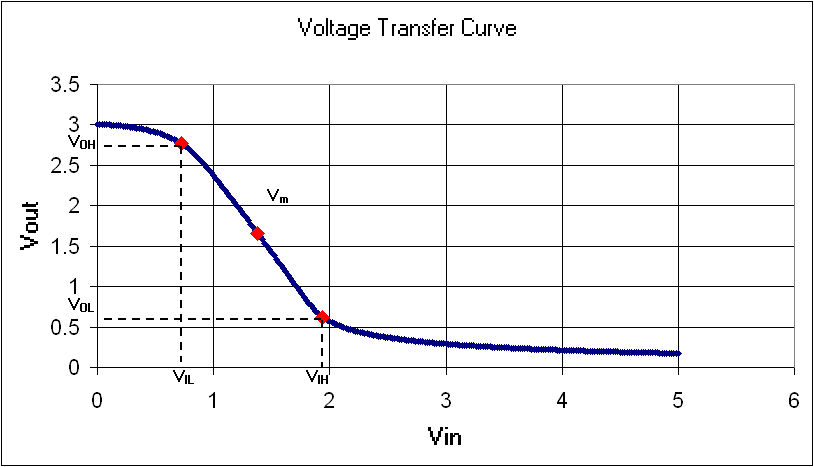 And this graph only covers voltage. A similar graph displaying input vs. output frequency is even worse.
What to do.
There are numerous ways designers have of overcoming a device limitation. For instance, a transistor's input vs. output is very non-linear at input levels below half a volt. So, imagine you're trying to amplify the tiny output voltage of a phono cartridge—maybe 0.005 volts. Yikes! That's so low the amplifying device wouldn't even recognize it!
The answer to that problem is simple and straightforward. We pre-apply to the transistor a steady, small, "turn-on" voltage. Now, when we next add the tiny voltage from the phono cartridge, the transistor will add that voltage to the steady voltage and we get a linear output response we can count on. At the device output, we remove the steady "turn-on" voltage and, what's leftover, is a perfect bigger version of the tiny phono cartridge output.
Bingo!
That process I just described is known in engineering circles as adding bias. And yes, you guessed it, the amount of that bias is categorized in familiar classes of operation like B, AB, and A. Remember? Class A or Class AB are well-known terms to audiophiles. They describe how much a device is constantly turned on with that steady turn-on voltage we will eventually throw away when we extract what we really want, the amplified output signal.
And, since today's Saturday and we can write a longer post, how do we throw away that steady voltage? Well, in vacuum tube amplifiers and simple transistor amplifiers, we place a blocking capacitor. What it blocks is that unwanted turn-on voltage (DC) and what it lets pass is the desired amplified audio signal. The quality and construction of that blocking capacitor has an enormous impact on how the eventual sound we hear is. (Of course, there are other means of doing this, I use this simple example only for means of explanation).
But that covers only one aspect of what we must do to make a non-linear device like a vacuum tube or transistor perform the way we wish. Other tools in the belt include feedback, both local and global, and many tricks of the trade all in service of getting a non-linear device closer to the ideal of linear.
And yes, all that we do impacts sound quality.
And this graph only covers voltage. A similar graph displaying input vs. output frequency is even worse.
What to do.
There are numerous ways designers have of overcoming a device limitation. For instance, a transistor's input vs. output is very non-linear at input levels below half a volt. So, imagine you're trying to amplify the tiny output voltage of a phono cartridge—maybe 0.005 volts. Yikes! That's so low the amplifying device wouldn't even recognize it!
The answer to that problem is simple and straightforward. We pre-apply to the transistor a steady, small, "turn-on" voltage. Now, when we next add the tiny voltage from the phono cartridge, the transistor will add that voltage to the steady voltage and we get a linear output response we can count on. At the device output, we remove the steady "turn-on" voltage and, what's leftover, is a perfect bigger version of the tiny phono cartridge output.
Bingo!
That process I just described is known in engineering circles as adding bias. And yes, you guessed it, the amount of that bias is categorized in familiar classes of operation like B, AB, and A. Remember? Class A or Class AB are well-known terms to audiophiles. They describe how much a device is constantly turned on with that steady turn-on voltage we will eventually throw away when we extract what we really want, the amplified output signal.
And, since today's Saturday and we can write a longer post, how do we throw away that steady voltage? Well, in vacuum tube amplifiers and simple transistor amplifiers, we place a blocking capacitor. What it blocks is that unwanted turn-on voltage (DC) and what it lets pass is the desired amplified audio signal. The quality and construction of that blocking capacitor has an enormous impact on how the eventual sound we hear is. (Of course, there are other means of doing this, I use this simple example only for means of explanation).
But that covers only one aspect of what we must do to make a non-linear device like a vacuum tube or transistor perform the way we wish. Other tools in the belt include feedback, both local and global, and many tricks of the trade all in service of getting a non-linear device closer to the ideal of linear.
And yes, all that we do impacts sound quality.
Linearity
by Paul McGowan
The term linearity as it applies to amplification suggests a ruler-flat straight line. That is, for a given input voltage we expect a mathematical relationship with the output voltage that can be graphically expressed as a straight line.
So, for example, with an amplifier designed with a gain of 10, for 1 volt in, we expect exactly 10 volts out at every frequency. Easy peasy. Only, that isn't what happens with amplifying elements.
Neither transistors nor vacuum tubes are natively linear with voltage or frequency, yet we expect them to perform as if they were.
Here's a simple graph of input vs. output voltage of an amplifying element. Note how only part of its response is a straight line.
 And this graph only covers voltage. A similar graph displaying input vs. output frequency is even worse.
What to do.
There are numerous ways designers have of overcoming a device limitation. For instance, a transistor's input vs. output is very non-linear at input levels below half a volt. So, imagine you're trying to amplify the tiny output voltage of a phono cartridge—maybe 0.005 volts. Yikes! That's so low the amplifying device wouldn't even recognize it!
The answer to that problem is simple and straightforward. We pre-apply to the transistor a steady, small, "turn-on" voltage. Now, when we next add the tiny voltage from the phono cartridge, the transistor will add that voltage to the steady voltage and we get a linear output response we can count on. At the device output, we remove the steady "turn-on" voltage and, what's leftover, is a perfect bigger version of the tiny phono cartridge output.
Bingo!
That process I just described is known in engineering circles as adding bias. And yes, you guessed it, the amount of that bias is categorized in familiar classes of operation like B, AB, and A. Remember? Class A or Class AB are well-known terms to audiophiles. They describe how much a device is constantly turned on with that steady turn-on voltage we will eventually throw away when we extract what we really want, the amplified output signal.
And, since today's Saturday and we can write a longer post, how do we throw away that steady voltage? Well, in vacuum tube amplifiers and simple transistor amplifiers, we place a blocking capacitor. What it blocks is that unwanted turn-on voltage (DC) and what it lets pass is the desired amplified audio signal. The quality and construction of that blocking capacitor has an enormous impact on how the eventual sound we hear is. (Of course, there are other means of doing this, I use this simple example only for means of explanation).
But that covers only one aspect of what we must do to make a non-linear device like a vacuum tube or transistor perform the way we wish. Other tools in the belt include feedback, both local and global, and many tricks of the trade all in service of getting a non-linear device closer to the ideal of linear.
And yes, all that we do impacts sound quality.
And this graph only covers voltage. A similar graph displaying input vs. output frequency is even worse.
What to do.
There are numerous ways designers have of overcoming a device limitation. For instance, a transistor's input vs. output is very non-linear at input levels below half a volt. So, imagine you're trying to amplify the tiny output voltage of a phono cartridge—maybe 0.005 volts. Yikes! That's so low the amplifying device wouldn't even recognize it!
The answer to that problem is simple and straightforward. We pre-apply to the transistor a steady, small, "turn-on" voltage. Now, when we next add the tiny voltage from the phono cartridge, the transistor will add that voltage to the steady voltage and we get a linear output response we can count on. At the device output, we remove the steady "turn-on" voltage and, what's leftover, is a perfect bigger version of the tiny phono cartridge output.
Bingo!
That process I just described is known in engineering circles as adding bias. And yes, you guessed it, the amount of that bias is categorized in familiar classes of operation like B, AB, and A. Remember? Class A or Class AB are well-known terms to audiophiles. They describe how much a device is constantly turned on with that steady turn-on voltage we will eventually throw away when we extract what we really want, the amplified output signal.
And, since today's Saturday and we can write a longer post, how do we throw away that steady voltage? Well, in vacuum tube amplifiers and simple transistor amplifiers, we place a blocking capacitor. What it blocks is that unwanted turn-on voltage (DC) and what it lets pass is the desired amplified audio signal. The quality and construction of that blocking capacitor has an enormous impact on how the eventual sound we hear is. (Of course, there are other means of doing this, I use this simple example only for means of explanation).
But that covers only one aspect of what we must do to make a non-linear device like a vacuum tube or transistor perform the way we wish. Other tools in the belt include feedback, both local and global, and many tricks of the trade all in service of getting a non-linear device closer to the ideal of linear.
And yes, all that we do impacts sound quality.
 And this graph only covers voltage. A similar graph displaying input vs. output frequency is even worse.
What to do.
There are numerous ways designers have of overcoming a device limitation. For instance, a transistor's input vs. output is very non-linear at input levels below half a volt. So, imagine you're trying to amplify the tiny output voltage of a phono cartridge—maybe 0.005 volts. Yikes! That's so low the amplifying device wouldn't even recognize it!
The answer to that problem is simple and straightforward. We pre-apply to the transistor a steady, small, "turn-on" voltage. Now, when we next add the tiny voltage from the phono cartridge, the transistor will add that voltage to the steady voltage and we get a linear output response we can count on. At the device output, we remove the steady "turn-on" voltage and, what's leftover, is a perfect bigger version of the tiny phono cartridge output.
Bingo!
That process I just described is known in engineering circles as adding bias. And yes, you guessed it, the amount of that bias is categorized in familiar classes of operation like B, AB, and A. Remember? Class A or Class AB are well-known terms to audiophiles. They describe how much a device is constantly turned on with that steady turn-on voltage we will eventually throw away when we extract what we really want, the amplified output signal.
And, since today's Saturday and we can write a longer post, how do we throw away that steady voltage? Well, in vacuum tube amplifiers and simple transistor amplifiers, we place a blocking capacitor. What it blocks is that unwanted turn-on voltage (DC) and what it lets pass is the desired amplified audio signal. The quality and construction of that blocking capacitor has an enormous impact on how the eventual sound we hear is. (Of course, there are other means of doing this, I use this simple example only for means of explanation).
But that covers only one aspect of what we must do to make a non-linear device like a vacuum tube or transistor perform the way we wish. Other tools in the belt include feedback, both local and global, and many tricks of the trade all in service of getting a non-linear device closer to the ideal of linear.
And yes, all that we do impacts sound quality.
And this graph only covers voltage. A similar graph displaying input vs. output frequency is even worse.
What to do.
There are numerous ways designers have of overcoming a device limitation. For instance, a transistor's input vs. output is very non-linear at input levels below half a volt. So, imagine you're trying to amplify the tiny output voltage of a phono cartridge—maybe 0.005 volts. Yikes! That's so low the amplifying device wouldn't even recognize it!
The answer to that problem is simple and straightforward. We pre-apply to the transistor a steady, small, "turn-on" voltage. Now, when we next add the tiny voltage from the phono cartridge, the transistor will add that voltage to the steady voltage and we get a linear output response we can count on. At the device output, we remove the steady "turn-on" voltage and, what's leftover, is a perfect bigger version of the tiny phono cartridge output.
Bingo!
That process I just described is known in engineering circles as adding bias. And yes, you guessed it, the amount of that bias is categorized in familiar classes of operation like B, AB, and A. Remember? Class A or Class AB are well-known terms to audiophiles. They describe how much a device is constantly turned on with that steady turn-on voltage we will eventually throw away when we extract what we really want, the amplified output signal.
And, since today's Saturday and we can write a longer post, how do we throw away that steady voltage? Well, in vacuum tube amplifiers and simple transistor amplifiers, we place a blocking capacitor. What it blocks is that unwanted turn-on voltage (DC) and what it lets pass is the desired amplified audio signal. The quality and construction of that blocking capacitor has an enormous impact on how the eventual sound we hear is. (Of course, there are other means of doing this, I use this simple example only for means of explanation).
But that covers only one aspect of what we must do to make a non-linear device like a vacuum tube or transistor perform the way we wish. Other tools in the belt include feedback, both local and global, and many tricks of the trade all in service of getting a non-linear device closer to the ideal of linear.
And yes, all that we do impacts sound quality.
- Choosing a selection results in a full page refresh.
- Opens in a new window.








